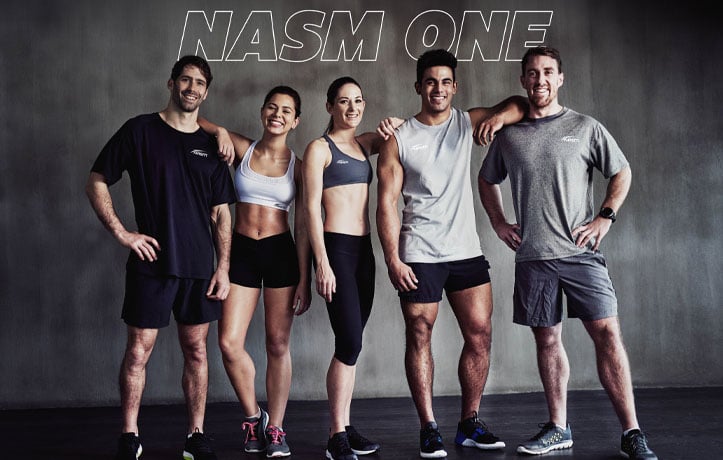The Optimum Performance Training (OPT™) model is a planned, systematic, periodized training system. It is designed to concomitantly improve all functional abilities including flexibility, core strength, muscular endurance, neuromuscular control, and cardiorespiratory efficiency. The OPT™ model has been extremely successful in helping fitness enthusiasts and athletes reduce body fat, increase lean muscle mass, improve strength, and enhance overall health and performance.
However, to be safe, effective, and productive, all Health and Fitness Professionals must be competent at designing and implementing integrated fitness programs with a variety of clients. Clients come from diverse backgrounds and all have different goals, needs, and abilities. The OPT™ program is designed to accommodate these diversities; however, the Health and Fitness Professional must also be prepared to provide the proper environment so each client has the greatest chance to succeed, regardless of how they define it. This is a challenging process entailing proper preparation, organization, and communication skills. Thus success will be defined by the ability to achieve whatever goal the participant has put in front of them and the Health and Fitness Professional’s ability to help them get to that goal in a safe and effective manner.
This article will discuss what to consider as a coach, and how to improve the chances of success for everyone participating in an exercise program. This article will also explore gym safety, exercise and spotting technique, program operations, communication, and coaching techniques. Having a thorough understanding of these necessities will position the Health and Fitness Professional as an expert to be sought after by people looking for someone to give them the plan, tools, and support necessary to achieve their goals.
Gym Safety
Health and Fitness Professionals need to be competent in designing and administering exercise programs that are fun, safe, and effective. Throughout their careers Health and Fitness Professionals will be instructing their clients how to improve overall fitness and sports performance utilizing a multitude of strength training methods and modes. The OPT™ program is oftentimes dynamic, intense, and multifaceted. As such, Health and Fitness Professionals and their clients must adhere to all best practices and facility policies to minimize the risk of injury or accidents.
Best practices, rules, and policies are important because they provide participants with guidelines regarding organization and behavior, as well as keeping a safe, clean, and professional environment in which all can enjoy their time and succeed. The following is a basic checklist Health and Fitness Professionals and patrons should follow to help ensure exercise programs are facilitated in the safest way possible. (1)
Safety Checklist
All gym training programs should take place during operational hours.
- Every member/client must complete an informed consent/waiver form.
- Every Certified Personal Trainer must hold a current CPR/AED certification.
- Prior to participation in an exercise program, all participants must undergo an orientation/assessment process.
- Each facility must have a properly documented emergency response system in place (first aid, AED).
- Clients with chronic disease (heart disease, diabetes, etc.) or moderate/severe musculoskeletal impairments (low back pain, knee pain, shoulder pain, etc.) require a signed medical release form prior to participation.
- Clients should not use unfamiliar equipment without proper instruction.
- Observe gym etiquette and courtesy toward others at all times.
- No horseplay.
- No offensive language or threatening acts of violence.
- Clients and Certified Personal Trainers must wear proper workout attire, especially shirts, shorts/pants, and athletic shoes, at all times.
- Demonstrate proper respect for gym equipment. Do not throw dumbbells or barbells at any time.
- Return equipment to its proper rack when finished.
- Ensure all equipment is in proper working condition and clean/sterilized.
- Keep facility path and exits clear and unobstructed.
- Maintain a safe distance from other participants during exercise.
- Clients MUST stop an exercise if feeling pain, faint, dizzy, lightheaded, or nauseous.
- Stop or regress an exercise if proper posture and exercise technique cannot be maintained.
- Certified Personal Trainers must be able to maintain line of sight and monitor all clients at all times during the exercise program.
- Report any problems, accidents, injuries, broken equipment, etc. in accordance with facility policies, procedures, and Occupational Safety and Health Administration (OSHA) standards.
- Stereo volume should be kept at a moderate volume.
- Certified Personal Trainers should spot clients during appropriate exercises such as the Bench Press, Military Press, and Barbell Squat exercise.
Spotting Techniques during Resistance Training
Health and Fitness Professionals must be competent and skilled in spotting techniques in order to maximize the effectiveness and safety of every resistance training session. Certain exercises such as the Bench Press, Military (Overhead) Press, and Barbell Squat require a spotter to maximize safety and provide clients with a sense of security, particularly when the client is new to weight lifting or performing a resistance exercise with heavy loads. When working with heavy weights, using a spotter helps to decrease the risk of serious injury. In fact, researchers have indicated that a decrease of injuries when lifting weights could be accomplished through more education, equipment warnings, and proper spotting technique. (2) Below is a brief checklist discussing appropriate spotting techniques.
- Determine how many repetitions the client/individual is going to perform before the initiation of the set.
- The spotter should stand in a stable, wide stance to maximize stability.
- Never take the weight away from the person (unless he/she is in immediate danger of dropping the weight). A proficient spotter provides just enough assistance for the client to successfully complete the lift.
- Spot at the client’s wrists instead of the elbows; especially if the client is using dumbbells. Spotting at the elbows does not prevent the elbows from flexing and caving inward (particularly during the Dumbbell Chest Press, Incline Dumbbell Chest Press, and Dumbbell Overhead Press).
- Spotters should provide enough assistance for clients to successfully complete a lift through the “sticking point”.
- Never spot a machine-based exercise by placing your hands underneath the weight stack.
- When spotting the Barbell Squat exercise, the spotter should be behind the participant and place his/her upper arms underneath the client’s armpits.
- Use multiple spotters when the amount of weight used in the squat exercise exceeds what a single spotter can safely lift. Two spotters will stand on opposite sides of the barbell. If necessary the spotters will assist the participant in completing the movements by lifting the ends of the barbell until he/she is able to finish the exercise.
Exercise Technique
Proper exercise technique and safety is paramount when initiating an exercise program. Certain precautions such as proper posture and breathing patterns must be explored and understood to maximize the effectiveness of the program, and more importantly, limit the possibilities of debilitating injury.
Proper Posture
Proper posture is essential during an exercise program to gain the best physiological response and ensure safety. Proper posture helps to ensure proper exercise technique and decreases unwanted stress on the spine and joints. Some common unwanted postures to avoid include excessively turning the feet outward, caving the knees inward (knock knees), arching the low back, and rounding the shoulders and head forward. These postures during exercise are dangerous and can potentially contribute to joint pain and injury.
There are five kinetic chain checkpoints that are recommended to review for each exercise to ensure that proper technique is being demonstrated. By maintaining proper alignment of these five checkpoints, the effectiveness of the exercise will be enhanced and there will be a decreased risk of injury. Regardless of body position (standing, prone, supine, multi-directional movement, or high velocities), proper alignment at each checkpoint needs to be maintained.
Exercise Progressions and Regressions
It is up to every Health and Fitness Professional to ensure every client is training in a safe environment that maximizes their performance potential. The Health and Fitness Professional will be working with a variety of clientele, all with different strengths, weaknesses, and conditioning. As such, it is the responsibility of the Health and Fitness Professional to properly select safe, yet challenging exercises. In order to accomplish this, a basic understanding of exercise progressions (making the exercise more challenging) and regressions (making the exercise easier) is important.
Breathing
Maintaining proper breathing patterns during exercise is extremely important, especially for clients with a chronic disease such as hypertension or other forms of heart disease. Correct breathing ensures the body is receiving adequate amounts of oxygen for working muscles. Proper breathing includes exhaling during the most strenuous phase of the concentric movement (sticking point) and inhaling during the eccentric phase. Avoid the Valsalva maneuver (exhaling against a closed glottis) because it can raise blood pressure and cause headaches, dizziness, or fainting. (3) Proper breathing during strenuous activity cannot be over emphasized.
Game Plan
It is imperative that the Health and Fitness Professional has a thorough understanding of each client’s goals, needs, and abilities. Remember the saying, “If you fail to plan, then you plan to fail.” Developing a game plan with each and every client will help to improve communication, enabling the Health and Fitness Professional to implement the proper motivational strategies to keep clients on track toward their fitness and performance goals.
To properly track and display a client’s progress throughout an OPT™ exercise program, utilize a regular re-assessment process. Re-assessments compare previous data to current data to help track a client’s progress in addition to helping clients stay motivated. Re-assessments are often performed every 4 weeks. Clients are more willing to stick with a program if they can see objective numbers displaying their progress (weight loss, muscle gain, etc.).
Using these tools and techniques to sell the vision and mission of the OPT™ exercise program will improve a client’s experience and assist with retention. The Health and Fitness Professional that successfully challenges clients to give 100% effort, while making the program fun, will benefit with a big book of business.
Operations
The integrated, multi-faceted design of the OPT™ model requires the Health and Fitness Professional to be organized and systematic in how he/she conducts a training session. Due to the integrated nature of the training program, the Health and Fitness Professional must be focused on the client, and be alert and attentive at ALL times in order to minimize accidents and/or injury risk. To minimize time spent focusing on the logistical aspects of the program, Health and Fitness Professionals should come to every session prepared to conduct the session as smoothly as possible, thus maximizing time spent providing clients with the best possible experience.
Coaching and Communication
Coaching clients is not an easy task. In order to be an effective coach, the Health and Fitness Professional should keep three things in mind:
- Be present! Focus on clients the entire time.
- Is the client doing things correctly?
- Is the client performing proper exercise technique?
- What can be done to help them do it better in the future?
- Understand proper exercise technique.
- A Health and Fitness Professional should never ask clients to perform an exercise he/she cannot properly demonstrate.
- Lead by example.
- While being able to recognize what is wrong with an exercise is crucial, Health and Fitness Professional also need to be able to correct what is wrong.
- Do not be lazy; it is the obligation of every Health and Fitness Professional to fix poor technique!
- Develop an arsenal of teaching cues to help clients achieve proper body position, awareness, alignment, and muscle activation. Examples include:
- “Pull your stomach away from your beltline.”
- “Keep your shoulders back and down.”
- “Pretend your feet are in skis and they are pointed straight ahead.”
- Place your index finger between your client’s shoulder blades and ask him/her to “squeeze your shoulder blades together as if you’re holding a pencil.”
- Different clients may need different cues- the best cue is the one that WORKS! Clear communication between the client and Health and Fitness Professional is imperative to the success of the exercise program and the client achieving his or her goals. The following are some key communication points to keep in mind to help the client get the most out of each training session:
- Ask questions!
- The only way to know if the client is satisfied with the program and his or her progress is to ask questions.
- The only way to know how and what the client is feeling during a training session is to ask questions.
- The only way to determine how to best help the client is to ask questions.
- Be an active listener.
- Be professional and stay positive—remember, it is not about you, it is about them.
- Speak clearly and concisely when providing exercise instruction.
Motivation
Knowing how to motivate and inspire a client to succeed ultimately boils down to knowing what he or she wants to achieve and WHY. (4) This information will help the Health and Fitness Professional to determine the best motivational strategy to help his or her client(s) stay on track. The assessment process is critical to client motivation for this very reason. The following are some key points to keep in mind when determining how to best motivate clients participating in an OPT™ exercise program:
- Lead by example.
- Be empathetic, not sympathetic.
- Re-assess and jointly review past data.
- Jointly reviewing past data and subsequent re-assessment data with clients helps to build confidence by seeing the progress they have made and helps motivate them to continue to achieve more. (5)
- Analyze the data.
- Analyzing a client’s data helps them to quickly determine which goals they are progressing toward, and which goals require new strategies or additional effort. (5)
- Supplementing long-term vision with near-term, proximal goals will help clients get and stay on course. Proximal goals lead to better performance, as well as a heightened sense of confidence, determination, and happiness. (6)
- Examining trends over time may reveal certain self-destructing habits and patterns that provide knowledge to enable “course correction” behaviors or strategies that will help the client get back on track to achieving their goals. (7)
Summary
To be safe, effective, and productive, all Health and Fitness Professionals must be competent at implementing and delivering OPT™ exercise programs with a variety of clients. When implementing the program, trainers must be cognizant of the client’s posture, exercise technique, breathing, and all gym safety guidelines. Moreover, no matter if the Health and Fitness Professional is working with a single client or a small group, it is his/her responsibility to be a positive, motivational leader to maximize the effectiveness of the program.
References:
- Tharrett S, Peterson J. Risk Management 101: 8 Ways to Reduce Your Business Risk. http://cms.ihrsa.org/index.cfm?fuseaction=Page.viewPage&pageId=18324&nodeID=15 (accessed May 24, 2010).
- Lombardi V, Troxel R. U.S. Injuries and Deaths Associated with Weight Training; Med Sci Sport and Exer. 2003, 35(5).
- MacDougall JD, Tuxen D, Sale DG, Moroz JR, Sutton JR. Arterial blood pressure response to heavy resistance exercise. J. Appl Physiol 1985; 58: 785-790.
- Krause SJ. Behavior Modification. In: Clark MA, Lucett SC, Corn RJ, eds. NASM Essentials of Personal Fitness Training. Baltimore, MD: Lippincott Williams & Wilkins; 2008: 465-475
- Cappuccio R. Professional Development. In: Clark MA, Lucett SC, Corn RJ, eds. NASM Essentials of Personal Fitness Training. Baltimore, MD: Lippincott Williams & Wilkins; 2008: 477-494.
- Bandura A, Simon K. The role of proximal intentions in self-regulation of refractory behavior. Cogn Ther Res. 1977; 1: 177-193.
- Palys TA, Little BR. Perceived life satisfaction and the organization of personal project systems. J Pers Soc Psychol. 1983; 44: 1221-1230.
















